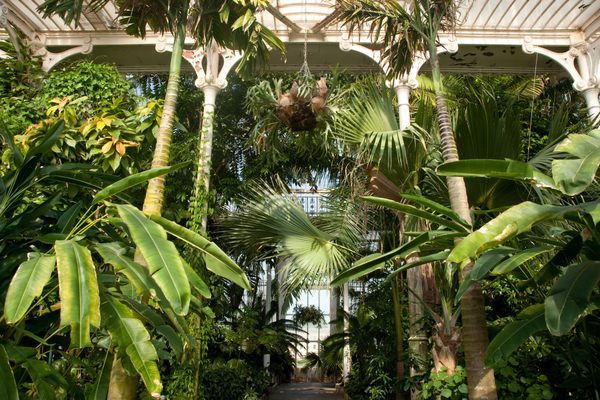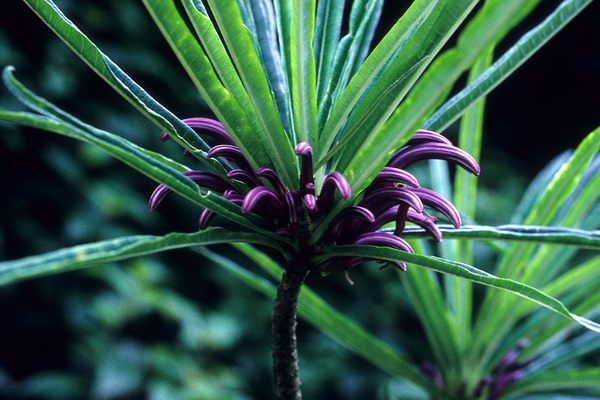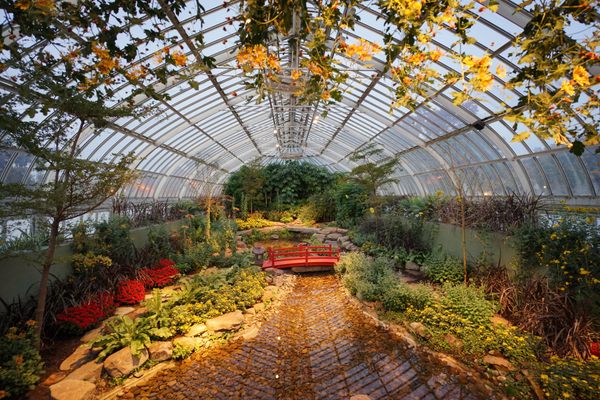A ‘Century Plant’ in Chicago Is Having an Epic Growth Spurt
It’s outgrown the greenhouse, and it’s a big greenhouse.

Agave americana, or the century plant, is native to Mexico and the deserts of the Southwest United States. Known for its broad, waxy leaves and ornamental spikes, the plant’s nickname comes from the fact that it takes a really long time to come into bloom—though not really 100 years. They bloom just once, at the end of their long lives. Now, one century plant in Chicago is showing that A. americana is worth waiting for. Currently, the plant has reached a towering 32 feet tall—too big for its greenhouse home—and is showing little sign of slowing down.
Back in 2016, this particular century plant began showing signs of growth, which wasn’t that surprising. The plant had been in the care of the Garfield Park Conservatory’s Desert House for more than five decades, but it was slow-going (growing) until winter hit this January and the century plant’s quiote (the central stalk that spreads seeds to reproduce) grew three feet in a month, from seven to 10 feet, including an impressive 11 inches in one weekend, followed by an astounding 7 inches in one day. “It’s not surprising,” says the unflappable Mary Eysenbach, Director of Conservatories at Chicago Parks District. “Just a little more unpredictable.”

This unpredictability refers to the fact that the tremendous growth spurt happened outside of its traditional season—and in captivity. Normally, century plants in their native desert environs flower during summer through late fall. “In [its natural] habitat it can often grow six inches a day,” conservatory floriculturist Ray Jorgensen told local television station WTTW. “What is unusual is that it’s doing it in the middle of winter.” Even though the xeric habitat of the Desert House—which is home to cacti, agaves, and euphorbia—mimics the century plant’s native conditions, the plant has been on Chicago’s seasonal schedule long enough that it is unusual that its growth period is not synced up to the climate outside—and the city just had a particularly brutal winter. Now we’re on the doorstep of summer and the plant continues its upward climb at the same pace.
Horticulturists at the conservatory suspect that watering has a lot to do with the rapid growth. “There are many factors that drive the plant’s reproductive cycle,” says Eysenbach. “However, we did start providing it with more water in January.” While some century plants’ inflorescences have been known to reach heights of 25 feet, the speed with which the conservatory’s grey-green plant has shot up is rare.

The Desert House’s ceiling is made of glass panes, and is only 25 feet high. Conservatory staff has already removed the glass panel just above the plant, and “the quiote has the support of the edges of the window frame if it needed it,” Eysenbach says. Warmer temperatures should fuel even more growth, so it appears the sky’s the limit (though brown lower leaves suggest that the end is in sight).
The century plant, for all its height, is not mature just yet. When it finally goes into bloom and produces seeds, that will be it: Death will follow. But there’s still something to see. According to Eysenbach, “there is another [agave] blooming now as well.”















Follow us on Twitter to get the latest on the world's hidden wonders.
Like us on Facebook to get the latest on the world's hidden wonders.
Follow us on Twitter Like us on Facebook